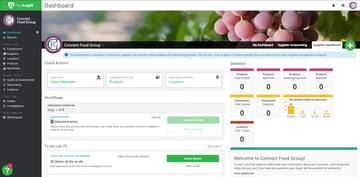Sixty-nine percent of businesses do not have full visibility of their supply chains, according to the Business Continuity Institute. Under FSMA guidelines, visibility of supplier documentation is essential to the safety of your food business. Implementing a management system for supplier documents will enable your team to promptly and strategically make decisions with ease based on current, real-time supplier data.
The complexity of moving food ingredients along the supply chain makes document management challenging, and if you use manual systems like spreadsheets, paper or even whiteboards, that complexity can cause confusion and disorganization. An automated document management system will allow you to find what you need to ensure quality and help provide the food safety your customers expect from your company. It will also prove to be beneficial in the event of an audit.
Benefits of Centralized Supplier Document Management
Implementing a centralized system for managing supplier documentation allows organizations to streamline reporting. Having a centralized document management system in place results in a more efficient process for locating information at a moment’s notice.
- Easily meet FMSA compliance with required record keeping and supplier documentation
- Create template workflows that allow implementation of corrective actions and support the collection of supplier verification documents
- Confirm exactly which suppliers have expired documentation, failed audits, or quality incidents
- Manage allergen declarations, Certificate of Analysis (COA) and raw material specifications from a centralized supplier document management dashboard
Supplier Approval Made Easy
In order to ensure all suppliers conform to your company’s quality and safety standards, you must validate new vendors. Gathering documents requires communication and collaboration with your team and suppliers. With the implementation of a supplier verification program, new suppliers are added following successful sampling and technical approval.
Creating standardized questionnaires, checklists, and ingredient requirements will expedite your approval process. According to an article by Food Quality and Safety, creating an approved supplier list should cover the basic criteria:
- GFSI recognized certification and provide a copy
- Provide COA’s for the product from an accredited lab
- Hazard analysis and critical control points plan
Periodic audits of the approved suppliers will safeguard a successful partnership. This allows you to manage your supply chain with companies that share your values for safety and quality. Once documents are received from a supplier, they must be verified, approved and maintained. Automation can provide reminders when documents are about to expire, which can help ensure that your organization is always compliant.
FoodLogiQ helps you manage critical supplier data so you get a real-time visualization of your supply chain. With FoodLogiQ’ Connect's Manage + Monitor dashboard, you can see which suppliers have expired documentation, failed audits or which suppliers have the most quality incidents.
To learn more, read how Compass Group selected FoodLogiQ Connect to help them streamline their supplier management and provide visibility into their supply chain.
Other posts you might be interested in
View All Posts
Supplier Compliance
6 min read
| October 11, 2016
Supplier Management Software: Ease FSMA Concerns & Centralize Supplier Info
Read More
Supplier Compliance
4 min read
| May 4, 2016
Working with Food Suppliers to Support Your Mission
Read More
Trustwell News
6 min read
| September 24, 2020

